![]()
Aroids and other genera in the Collection
Take the Tour Now?
Orchids
The
Exotic Rainforest
Plants in
the Exotic Rainforest Collection
Images on this website are copyright protected. Contact us before
attempting to reuse.
Anthurium regale
Linden
Growth of an
inflorescence
Please note:
This page contains numerous photographic images.
If you are using a dial-up connection the time may be longer
than expected.
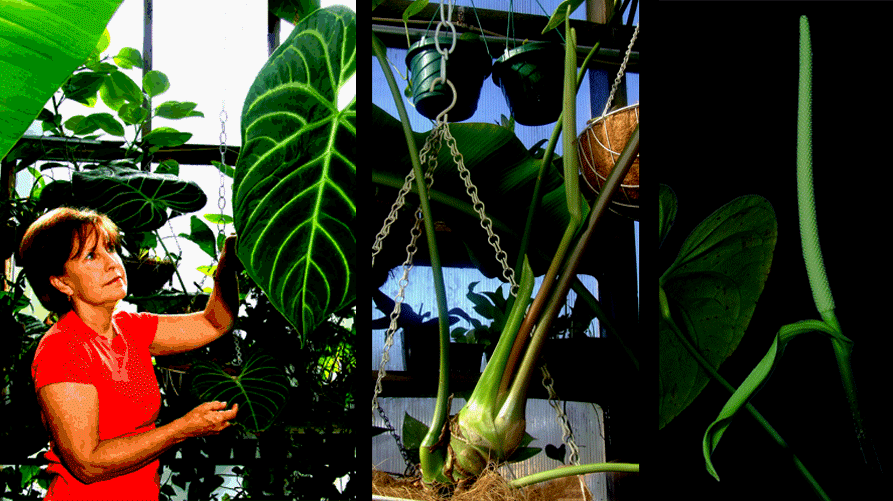
Photos ©
2006/2007 Steve Lucas
Anthurium
regale
Linden
Growth of an inflorescence
Growth of an inflorescence
Page 3 of 6
Includes Day 17 through
Day 31
See Page 2 for the definitions of botanical terms used in this description.
This is Page
3, the second
page showing photos of the growth of our
Anthurium regale spathe and spadix. The large number of photographs has
made it almost impossible for those with a dial-up connection to from
a single page. If you found yourself on this page without reading the first two
pages Click Below to go to Page 1, Page 2 or Page 4:
Anthurium regale spathe and spadix. The large number of photographs has
made it almost impossible for those with a dial-up connection to from
a single page. If you found yourself on this page without reading the first two
pages Click Below to go to Page 1, Page 2 or Page 4:
Anthurium regale Page 1
To read our observations regarding this species click on this link
Anthurium regale
spathe and spadix Page 2
Day 1 through 16
Anthurium regale spathe and spadix Page 4 Day 32 through 44
Anthurium regale spathe and spadix Page 4 Day 32 through 44
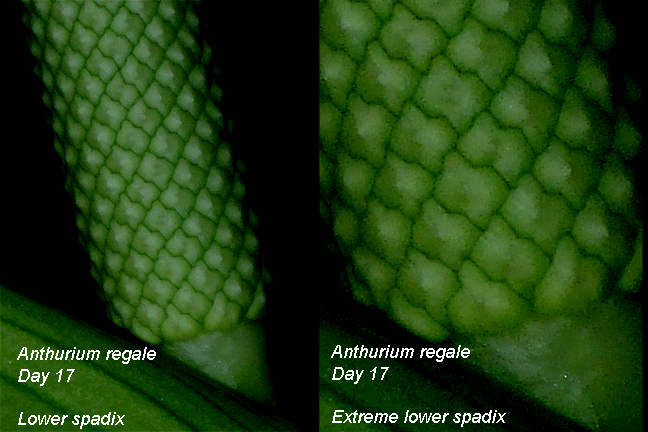
Day 17: At 9:00AM no visible
nectar exudate can be observed. No noticeable scent was detected.
The right photo is approximately 6 times life size.
The right photo is approximately 6 times life size.
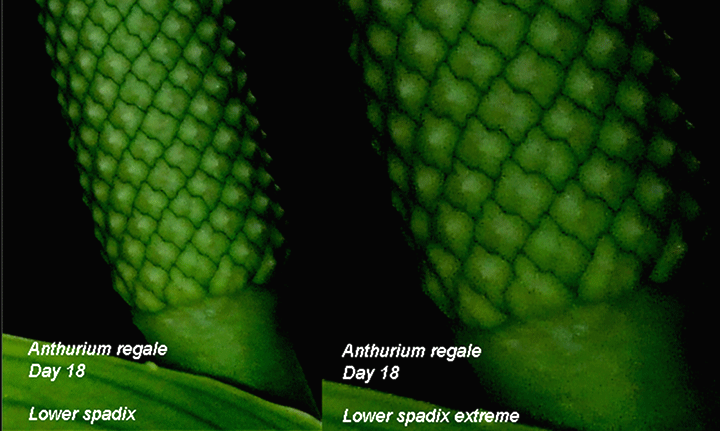
Day 18: No noticeable change.
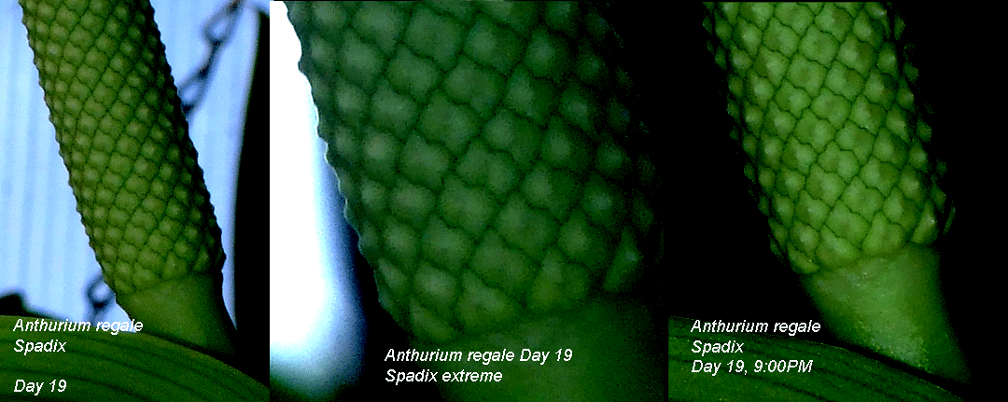
Day 19: Today my wife Janice tried
to discern any noticeable scent. None could be detected. An
interesting note
came from Dr. Ron Kaufmann in San Diego,
"One issue that was
brought to my attention when I was trying to
pollinate one of my big Anthuriums was that sometimes the exudate appears at night then "vanishes" during the day.
As it turned out, my plant produced that exudate during the day, but the notion that the inflorescence might be most
receptive to pollen at night stuck with me." As a result of Dr. Kaufmann's suggestion I photographed the spadix
approximately 4 hours after the sun had set. No scent or exudate could be seen or noticed. However, the
"nipples" of many of the perigones appear to be more enlarged, especially if compared to the photos of
Day 18 and earlier.
pollinate one of my big Anthuriums was that sometimes the exudate appears at night then "vanishes" during the day.
As it turned out, my plant produced that exudate during the day, but the notion that the inflorescence might be most
receptive to pollen at night stuck with me." As a result of Dr. Kaufmann's suggestion I photographed the spadix
approximately 4 hours after the sun had set. No scent or exudate could be seen or noticed. However, the
"nipples" of many of the perigones appear to be more enlarged, especially if compared to the photos of
Day 18 and earlier.

Day 20: When compared with Day 18
it appears the center of each perigone is continuing to enlarge.
Still no obvious nectar apparent.
Still no obvious nectar apparent.
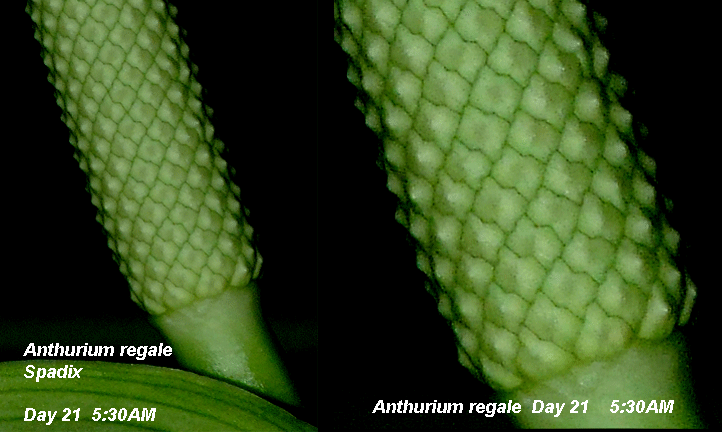
Day 21: In an effort to determine
if the nectar's exudate could be seen at night these photos were taken at 5:30AM.
Still nothing apparent.
Still nothing apparent.
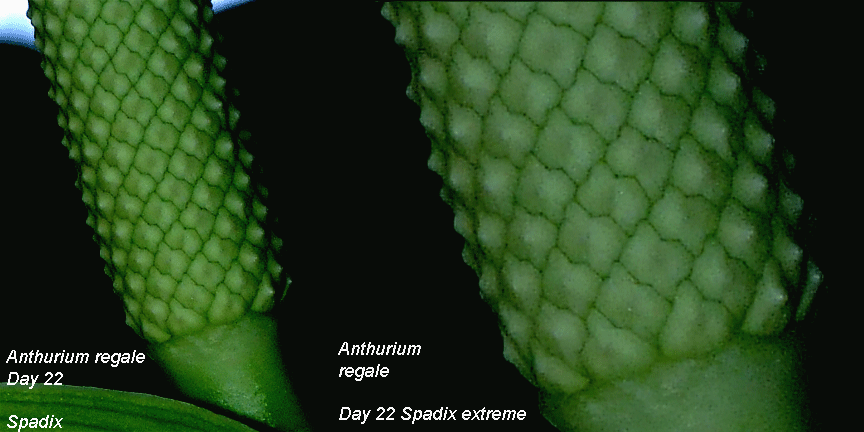
Day 22: No apparent sign of the
exudate, however it appears some development of stigmas is beginning
to immerge from the center of' "nipple" of some perigones on the extreme right side of the spadix. When
looking at this magnification keep in mind the actual spadix is 1.5cm (less than 5/8 inch) in width. See
Day 7 and Day 9 for a lifesize comparison.
to immerge from the center of' "nipple" of some perigones on the extreme right side of the spadix. When
looking at this magnification keep in mind the actual spadix is 1.5cm (less than 5/8 inch) in width. See
Day 7 and Day 9 for a lifesize comparison.
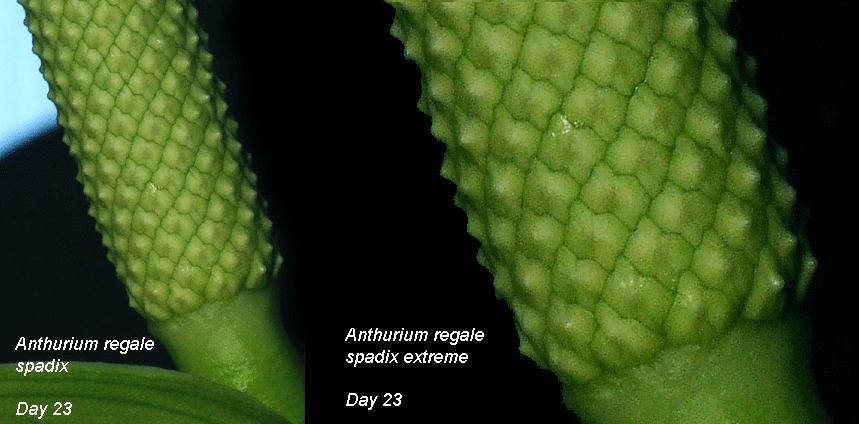
Day 23: These photos were taken at
approximately 8:30AM. Several areas of the perigones appear to
be moist. I am uncertain if this is the nectar exudate I have been hoping to photograph. No scent can be detected.
Perhaps, after 23 days, anthesis has finally begun.
be moist. I am uncertain if this is the nectar exudate I have been hoping to photograph. No scent can be detected.
Perhaps, after 23 days, anthesis has finally begun.

Day 24:
I'm watching closely for the
next phase to begin.
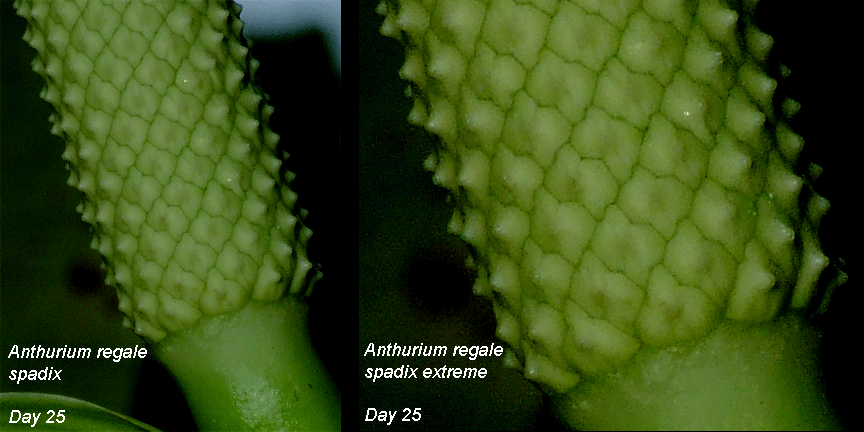
Day 25: I
tried that very thing this morning and could feel the moisture.
Dr. Croat has encouraged
me to check often for a scent, but none can be detected. The fluid feels very much like a light machine oil but
me to check often for a scent, but none can be detected. The fluid feels very much like a light machine oil but
seems to evaporate quickly once on
your fingers. Still, 5 minutes later I can feel the oil between my
fingers.
Some weeks ago my friend "Dr." Julius
Boos, the International Aroid Society's resident expert, offered
these observations. I believe now is the appropriate time to include them in this discussion so we can all watch
for the next phase to develop, "Underneath and protected by each segment of perigone are the male parts, generally
four if you have four segments of perigone, the male structures consist of a two-lobed stamen, the lobes sit at the top
of a long thin stem, and the lobes will just barely protrude from underneath each perigone segment and produce pollen
at male anthesis. This is VERY difficult to observe unless you have a good hand-lens, but you will see the pollen
when it begins to be produced. If you have a berry developing, you will see the 'egg' getting larger, pushing apart
the four perigone segments at their top, and beginning to protrude out and away from the spadix, and from the other
flowers on the spadix."
these observations. I believe now is the appropriate time to include them in this discussion so we can all watch
for the next phase to develop, "Underneath and protected by each segment of perigone are the male parts, generally
four if you have four segments of perigone, the male structures consist of a two-lobed stamen, the lobes sit at the top
of a long thin stem, and the lobes will just barely protrude from underneath each perigone segment and produce pollen
at male anthesis. This is VERY difficult to observe unless you have a good hand-lens, but you will see the pollen
when it begins to be produced. If you have a berry developing, you will see the 'egg' getting larger, pushing apart
the four perigone segments at their top, and beginning to protrude out and away from the spadix, and from the other
flowers on the spadix."
I'm pushing my photographic equipment to
the absolute limit trying to photograph each stage of this event but
hopefully we will be able to photograph and illustrate what Dr. Croat and Julius have described. If you
have the skill to see things developing that I miss please be sure and point them out. Since few have apparently
observed Anthurium regale flower this is a learning process for all of us. An interesting note was emailed today
from Enid at Natural Selections Exotics in Fort Lauderdale. She says Ree Garden in Miami has several of these
plants currently in flower. If you live in the Miami area you might want to visit to see this event in person.
hopefully we will be able to photograph and illustrate what Dr. Croat and Julius have described. If you
have the skill to see things developing that I miss please be sure and point them out. Since few have apparently
observed Anthurium regale flower this is a learning process for all of us. An interesting note was emailed today
from Enid at Natural Selections Exotics in Fort Lauderdale. She says Ree Garden in Miami has several of these
plants currently in flower. If you live in the Miami area you might want to visit to see this event in person.
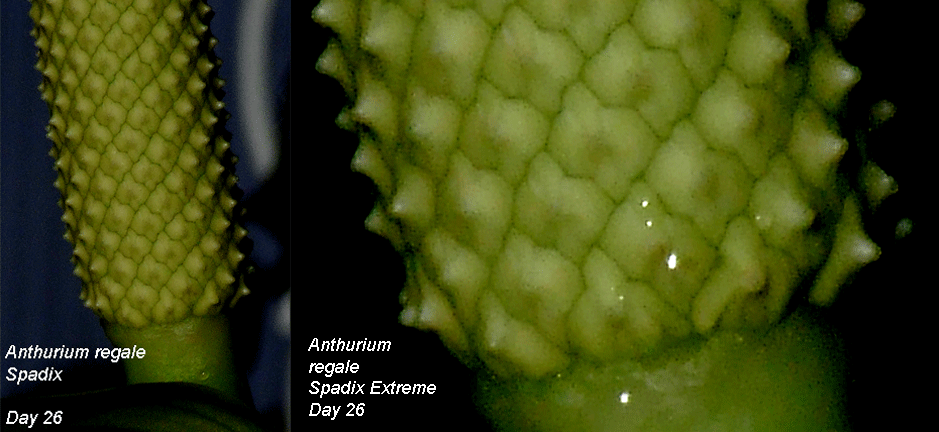
Day 26: Late in the evening of Day 25 Dr. Croat made this observation, "I thought I saw some evidence of liquid
but certainly there is no strong evidence that you have reached female anthesis. Well, in any event until you get some
pollen it is mute question." I then asked him if the stamens would be visible enough to photograph and he
responded, "The stamens, if they emerge, will be very obvious. I do not recall whether they remain exposed or are
retracted after some hours. I would bet they stay emergent. If you are picking up liquid it is probably at anthesis.
When you are finished you will have the most complete record of flowering behavior of Anthurium ever recorded.
Remember that we canít be sure that this thing is not producing scent at night but I am not sure what it would be
attracting at night. I believe that some species are pollinated by little insects only about 2mm long in the wild."
As a result of Dr. Croat's suggestion I
set the alarm
and checked the spadix for a scent at 2:00AM. I then
checked again at 7:00AM and Janice checked at 9:00AM and 11:00AM. The exudate could be felt on my
fingers, but still nothing to report regarding a scent. The reflections in the enlarged photo are not exudate.
Those are water droplets that have fallen from the ceiling. However, it appears dried exudate can be seen
accumulating just at the base beneath the perigones in both photos. The enlarged photo is approximately
10 times life size.
checked again at 7:00AM and Janice checked at 9:00AM and 11:00AM. The exudate could be felt on my
fingers, but still nothing to report regarding a scent. The reflections in the enlarged photo are not exudate.
Those are water droplets that have fallen from the ceiling. However, it appears dried exudate can be seen
accumulating just at the base beneath the perigones in both photos. The enlarged photo is approximately
10 times life size.
As a point of reference, scroll back up
to the Day 17 photos. You can easily see the "nipple" of the floret
has
expanded its size. In fact, if you look closely you can see the "expansion" from Day 25 to Day 26. Janice felt,
when using a strong magnifying glass, she could see evidence of stamen beginning to protrude but I am
unable to verify that photographically. Good photography is very difficult today since we are having an ice
storm and it is near dark outside. The nice thing about our atrium is it still feels like the tropics inside!
expanded its size. In fact, if you look closely you can see the "expansion" from Day 25 to Day 26. Janice felt,
when using a strong magnifying glass, she could see evidence of stamen beginning to protrude but I am
unable to verify that photographically. Good photography is very difficult today since we are having an ice
storm and it is near dark outside. The nice thing about our atrium is it still feels like the tropics inside!
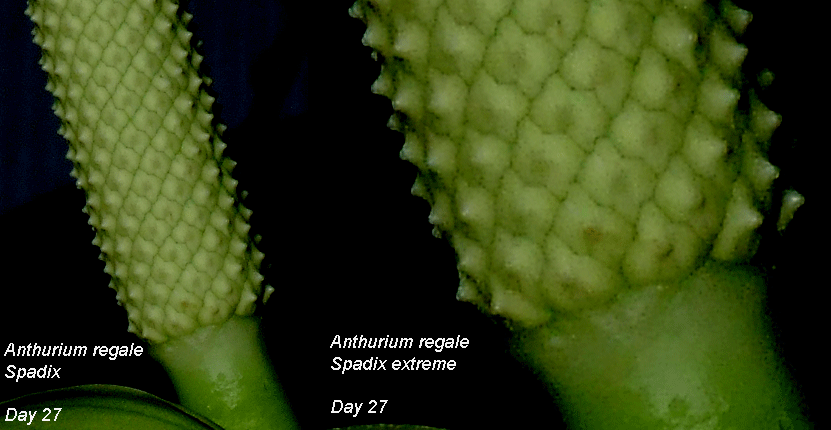
Day 27: Late in the afternoon
of day 26 "Dr." Julius
sent this observation, "It most
definitely is in female anthesis
now, I can see droplets on some of the stigma tips, but in this species the liquid seems much more 'runny', spreading
down quickly while in other species, like A. andreanum which I have observed, the droplets remain on the very tips
of the stigmas and look like tiny little balls of crystal, and when in male anthesis the tips of the stigmas have obviously
turned dry and brown." Just a personal observation, but Julius and I tend to agree the thin exudate is likely due
to the extremely high humidity in the atrium.
now, I can see droplets on some of the stigma tips, but in this species the liquid seems much more 'runny', spreading
down quickly while in other species, like A. andreanum which I have observed, the droplets remain on the very tips
of the stigmas and look like tiny little balls of crystal, and when in male anthesis the tips of the stigmas have obviously
turned dry and brown." Just a personal observation, but Julius and I tend to agree the thin exudate is likely due
to the extremely high humidity in the atrium.
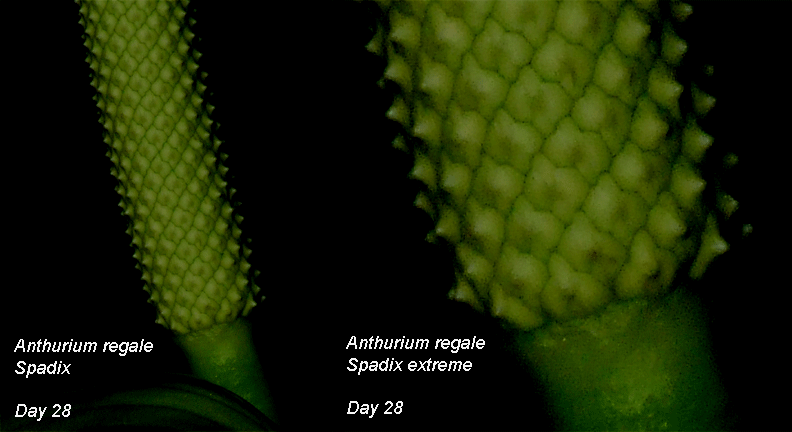
Day 28: No evidence of a scent can be detected.
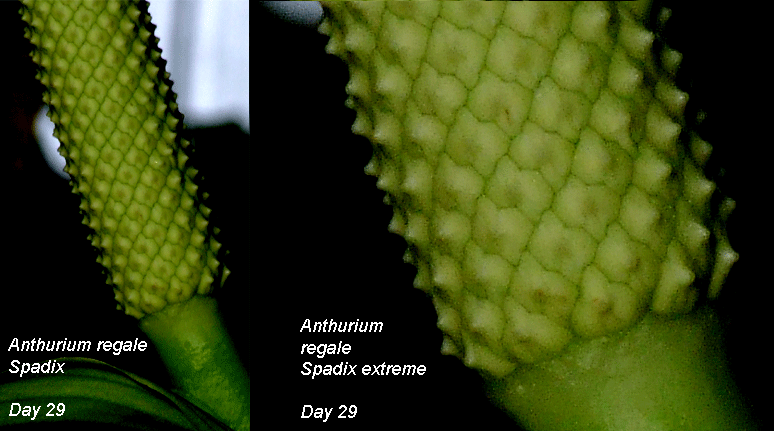
Day 29: Still no evidence of a scent can
be detected.
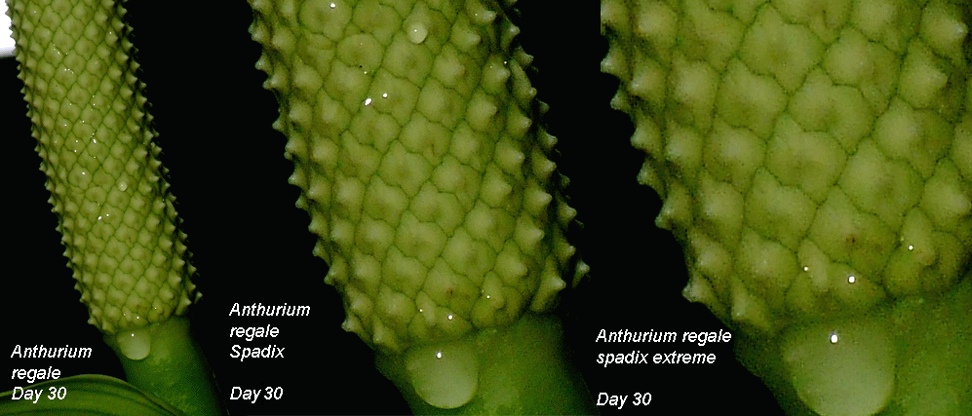
Day 30: Today there were major
accumulations of liquid nectar at points all over the spadix. At first I
suspected humidity
dripping from the ceiling but when the liquid at the bottom of the perigones was examined it had the consistency
of a very light oil. Cloudiness can easily be seen in the liquid. Dr. Croat indicated this afternoon the droplets
consist of sugar solutions. When tasted they were bitter sweet. There is still no evidence of a scent. Dr. Croat
then commented "I would definitely say that it must be at anthesis despite the lack of smell." The first photo is slightly
greater than twice life size. The center photo is approximately 4 times life size, and the third (best guesstimate)
is approximately 7 to 8 times life size. When Julius viewed the photos he commented, "I am now certain that the
female anthesis is occurring, as in the most recent photos you can actually see the globular drops of nectar on the very
points of the stigmas before the quantity of this liquid being produced makes them run down the spadix."
dripping from the ceiling but when the liquid at the bottom of the perigones was examined it had the consistency
of a very light oil. Cloudiness can easily be seen in the liquid. Dr. Croat indicated this afternoon the droplets
consist of sugar solutions. When tasted they were bitter sweet. There is still no evidence of a scent. Dr. Croat
then commented "I would definitely say that it must be at anthesis despite the lack of smell." The first photo is slightly
greater than twice life size. The center photo is approximately 4 times life size, and the third (best guesstimate)
is approximately 7 to 8 times life size. When Julius viewed the photos he commented, "I am now certain that the
female anthesis is occurring, as in the most recent photos you can actually see the globular drops of nectar on the very
points of the stigmas before the quantity of this liquid being produced makes them run down the spadix."
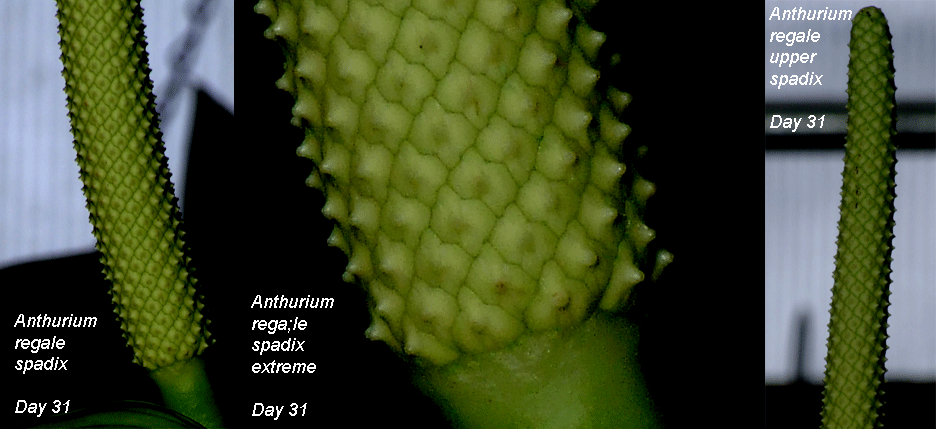
Day 31: Just a personal
observation: It appears the female anthesis on the lower spadix may be
ending. There is
little sign of nectar's exudate on Day 31. An examination of the upper spadix reveals some liquid but nothing close to the
amount visible on Day 30. Only a dried remnant can be seen both on and beneath the perigones. Still no apparent
scent.
little sign of nectar's exudate on Day 31. An examination of the upper spadix reveals some liquid but nothing close to the
amount visible on Day 30. Only a dried remnant can be seen both on and beneath the perigones. Still no apparent
scent.